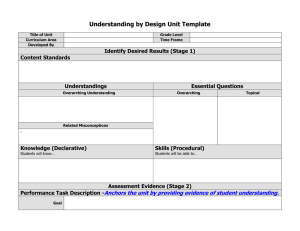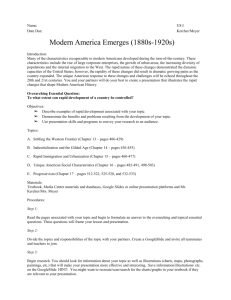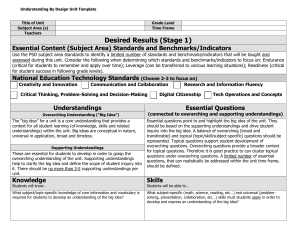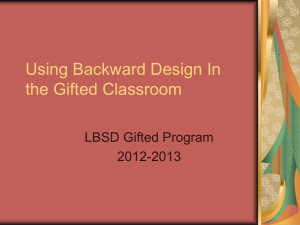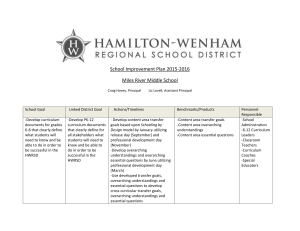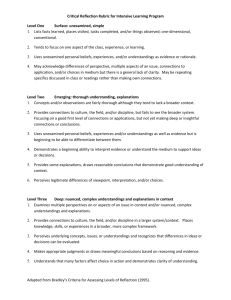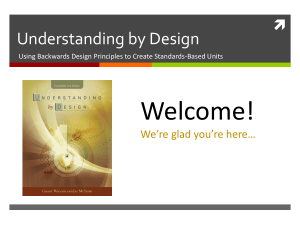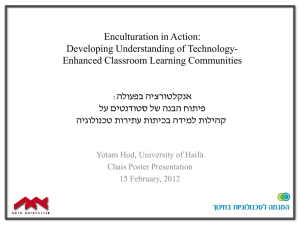What are Big Ideas?
advertisement
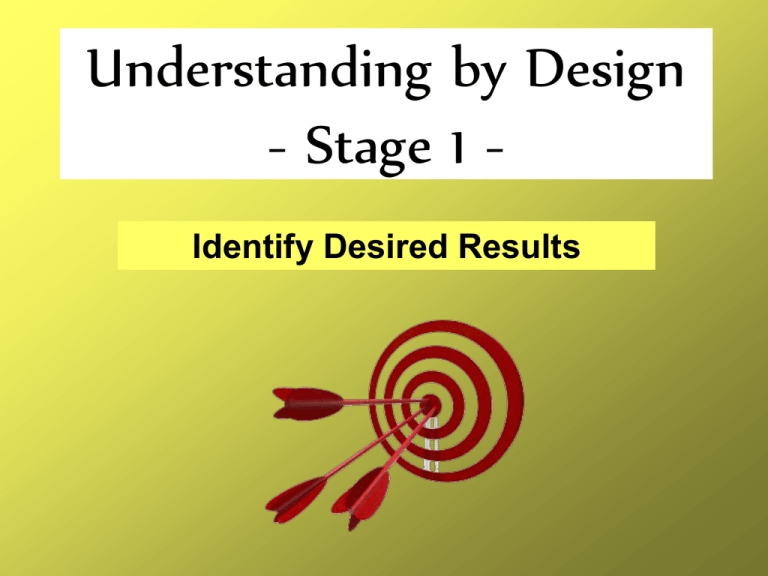
Understanding by Design - Stage 1 Identify Desired Results Stage 1 Key Design Elements • “BIG IDEAS” • Learning Targets • Understandings (Key, enduring, essential, overarching, topical) • Essential Questions • Knowledge • Skills What are the “Big Ideas” of UbD? What are “Big Ideas”? • • • • • Broad and abstract Represented by few words Universal in application Timeless Transferable Concept / Theme / Theory / Principle What are the “Big Ideas” in PE? What could Big Ideas be for Movement? • Distribute Summary Chart • In pairs determine what might constitute the “Big Ideas” in Physical Education What are the Understandings? Characteristics of Understandings: 1. They are framed as complete sentences and specify something to be understood. 2. They focus on “Big Ideas”. 3. They need to be uncovered. There are two kinds! Overarching Understandings: • They are general and point to big ideas. • They are recurring ideas that frame coursework. • They answer the “So What” question that students sometimes have. Topical Understandings: • They are topic specific insights Students should understand that… Create an Overarching Understanding What could an Overarching Understanding be based on the “Big Ideas” that you will be created? Essential Questions from our Big Ideas • Essential Questions are generated from Big Ideas and form the basis for our lessons and student learning by linking knowledge and skills to a greater purpose and creating deeper understanding. What are Essential Questions? • Questions based on Big Ideas that frame learning goals of a course. (May have several for a Big Idea). • They are not answerable with finality in a brief sentence • They stimulate on-going thought and debate as new experiences help clarify them for learners. • They provide focus for the Big Ideas throughout a course using language that is understandable by students Essentials of essential questions • • • • • Answers cannot be found, they must be constructed They cast old knowledge, ideas, texts, in a new light They generate multiple answers and perspectives They generate more questions They lead to discovery and uncovering, rather than simply covering, a topic • They are engagingly framed • They are higher-order; they always take us to analysis, synthesis, and evaluation • Students must go beyond the information given to develop their answers Examples of overarching essential questions What kind of practice “makes perfect”? What feedback will enhance or improve performance most? What makes a movement “basic”? What motivates people to be active? How do rules affect sports? What makes play “fair”? What makes an athlete a “superstar”? How might sports look without officials? How can a person best show their skill? How can I gain the confidence to perform? How good is good enough? Create Essential Questions Based on the “Big Ideas” and “Overarching Understandings” what might be some essential questions? Learning Targets • Divide into three groups: – Grade 3 – Grade 6 – Grade 9 • Identify targets for a unit using a territory/ invasion game. – At least 5 learning outcomes Unpacking the Curriculum • Select an outcome to unpack • Identify the verbs • Identify the nouns What then will the students know and be able to do Unpacking the Curriculum Student Learning Outcome: Select and refine balance abilities (i.e., static, dynamic), applying biomechanical principles (i.e., force, motion, balance), using a variety of equipment (e.g., skates, skis, boards, stilts, pogo sticks...) related to activity-specific physical activity skills Verbs (How students will show what is required) Select Refine Apply Use Nouns (What students are required to know) Balance Abilities Biomechanical Principles Equipment Activity-specific Physical Activity Skills Create a Topical Understanding What could some Topical Understandings be based on the unit that you created? Keep the overarching understandings and SLO’s in mind. Create a Topical Essential Question What could some Topical Essential Questions be based on the unit that you created? Keep the overarching essential questions understandings and SLO’s in mind. Clarifying Content Priorities Worth being familiar with Trivial Knowledge or Skills: • • • • (Necessary for the Unit/Lesson) Facts Non-essential Terminology Definitions, Dates, People, Dimensions Clarifying Content Priorities Guided by Curricular Outcomes: Important to know and do Foundational Knowledge / Skills: • Basic Movement Skills • FITT Principle • Fair Play • Important knowledge/skills/concepts • Significant connections and transfer power • Prerequisites needed to successfully accomplish complex performances of understanding Clarifying Content Priorities Non-negotiables The Discipline does not exist without it! Big Ideas & Core Tasks How does your plan fit with the priorities? Worth being familiar with Important to know and do Big Ideas & Core Tasks So… Instead of thinking of content as “stuff” to be covered or “things to do”, consider knowledge and skill as the means of addressing questions central to understanding the key issues in our discipline. Thank you for continuing our journey!


